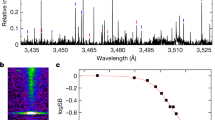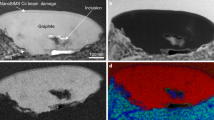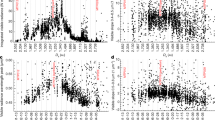Abstract
II. The Cases of Nova Orionis and R Geminorum. THE stars with bright carbon flutings, the same as those seen in comets, are not limited to first-magnitude stars, such as a Orionis, but include at least one new star, Nova Orionis. Because the latter star lasted but a short time we might expect the phenomena presented to be different from those found in the first-magnitude star, which is a variable, like others with similar composite spectra. Practically there is little difference, for in a Orionis, a Herculis, and others of that type, we find well-marked dark absorption flutings of manganese, as well as line-absorption of sodium and magnesium.2 The absorptions are not so well developed in the Nova, for the reason, perhaps, that condensation due to gravity had not taken place to such a great extent, so that the heat of the stones themselves was not so great, and further because the local absorption around each meteorite would be cloaked by the bright radiation of the interspaces, which gives, as in comets, the maximum inten sity to the bright fluting, wave-lengthily. In R Geminorum the demonstration of the same meteoric constitution, but without the strong absorption, is given by the fact that in that star so much of the light proceeds from the vapour produced by the meteorites, and from the carbon in the interspaces, that the carbon flutings and the bright lines of barium and strontium, and other substances present in meteorites, are visible at the same time, exactly as they are seen in the glow over a meteorite in an experimental tube, in which, as the pressure is reduced, the edges alone of the carbon flutings are visible, and put on the appear ance of bright lines, almost exactly resembling the bright lines of the heated meteorites.
This is a preview of subscription content, access via your institution
Access options
Subscribe to this journal
Receive 51 print issues and online access
$199.00 per year
only $3.90 per issue
Buy this article
- Purchase on Springer Link
- Instant access to full article PDF
Prices may be subject to local taxes which are calculated during checkout
Similar content being viewed by others
References
Potsdam Observations, vol. iv. No. 14.
Konkoly, Astr. Nach. 2712, D3 and F; Riccó indicates D3 in Astr. Nach. 2707.
Article on “Meteorites,” Prof. Newton, “Encyclopædia Britannica,” vol. xvi.
NATURE, vol. xvi. p. 413.
Rights and permissions
About this article
Cite this article
LOCKYER, J. Researches on Meteorites 1 . Nature 37, 80–87 (1887). https://doi.org/10.1038/037080a0
Issue Date:
DOI: https://doi.org/10.1038/037080a0
Comments
By submitting a comment you agree to abide by our Terms and Community Guidelines. If you find something abusive or that does not comply with our terms or guidelines please flag it as inappropriate.



